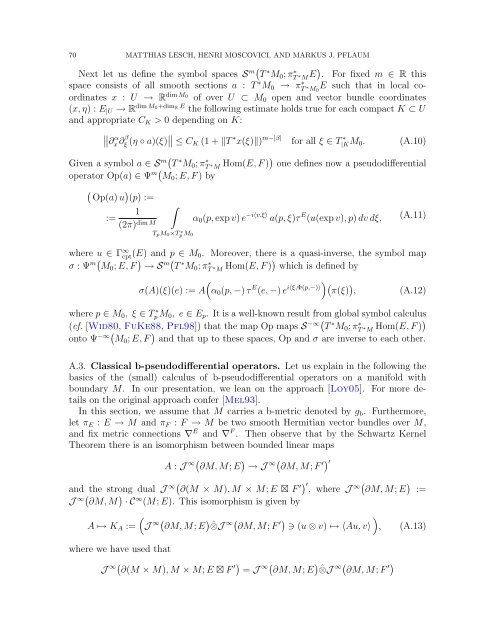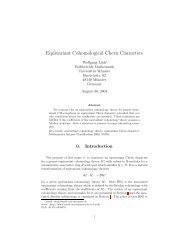Connes-Chern Character for Manifolds with Boundary and ETA ...
Connes-Chern Character for Manifolds with Boundary and ETA ...
Connes-Chern Character for Manifolds with Boundary and ETA ...
You also want an ePaper? Increase the reach of your titles
YUMPU automatically turns print PDFs into web optimized ePapers that Google loves.
70 MATTHIAS LESCH, HENRI MOSCOVICI, AND MARKUS J. PFLAUM<br />
Next let us define the symbol spaces S m( T ∗ M 0 ; πT ∗ ∗ M E) . For fixed m ∈ R this<br />
space consists of all smooth sections a : T ∗ M 0 → πT ∗ ∗ M 0<br />
E such that in local coordinates<br />
x : U → R dim M 0<br />
of over U ⊂ M 0 open <strong>and</strong> vector bundle coordinates<br />
(x, η) : E |U → R dim M 0+dim R E the following estimate holds true <strong>for</strong> each compact K ⊂ U<br />
<strong>and</strong> appropriate C K > 0 depending on K:<br />
∥ ∂<br />
α<br />
x ∂ β ξ (η ◦ a)(ξ)∥ ∥ ≤ CK (1 + ‖T ∗ x(ξ)‖) m−|β| <strong>for</strong> all ξ ∈ T|KM ∗<br />
0 . (A.10)<br />
Given a symbol a ∈ S m( T ∗ M 0 ; πT ∗ ∗ M Hom(E, F )) one defines now a pseudodifferential<br />
operator Op(a) ∈ Ψ m( M 0 ; E, F ) by<br />
( )<br />
Op(a) u (p) :=<br />
∫<br />
1<br />
:=<br />
α<br />
(2π) dim M<br />
0 (p, exp v) e −i〈v,ξ〉 a(p, ξ)τ E (u(exp v), p) dv dξ, (A.11)<br />
T pM 0 ×T ∗ p M 0<br />
where u ∈ Γ ∞ cpt(E) <strong>and</strong> p ∈ M 0 . Moreover, there is a quasi-inverse, the symbol map<br />
σ : Ψ m( M 0 ; E, F ) → S m( T ∗ M 0 ; πT ∗ ∗ M Hom(E, F )) which is defined by<br />
(<br />
) (π(ξ) )<br />
σ(A)(ξ)(e) := A α 0 (p, −) τ E (e, −) e i〈ξ,Φ(p,−)〉 , (A.12)<br />
where p ∈ M 0 , ξ ∈ Tp ∗ M 0 , e ∈ E p . It is a well-known result from global symbol calculus<br />
(cf. [Wid80, FuKe88, Pfl98]) that the map Op maps S −∞( T ∗ M 0 ; πT ∗ ∗ M Hom(E, F ))<br />
onto Ψ −∞( M 0 ; E, F ) <strong>and</strong> that up to these spaces, Op <strong>and</strong> σ are inverse to each other.<br />
A.3. Classical b-pseudodifferential operators. Let us explain in the following the<br />
basics of the (small) calculus of b-pseudodifferential operators on a manifold <strong>with</strong><br />
boundary M. In our presentation, we lean on the approach [Loy05]. For more details<br />
on the original approach confer [Mel93].<br />
In this section, we assume that M carries a b-metric denoted by g b . Furthermore,<br />
let π E : E → M <strong>and</strong> π F : F → M be two smooth Hermitian vector bundles over M,<br />
<strong>and</strong> fix metric connections ∇ E <strong>and</strong> ∇ F . Then observe that by the Schwartz Kernel<br />
Theorem there is an isomorphism between bounded linear maps<br />
A : J ∞( ∂M, M; E ) → J ∞( ∂M, M; F ′) ′<br />
<strong>and</strong> the strong dual J ∞( ∂(M × M), M × M; E ⊠ F ′) ′ ( , where J<br />
∞<br />
∂M, M; E ) :=<br />
J ∞( ∂M, M ) · C ∞ (M; E). This isomorphism is given by<br />
(<br />
A ↦→ K A := J ∞( ∂M, M; E ) ˆ⊗J ∞( ∂M, M; F ′) )<br />
∋ (u ⊗ v) ↦→ 〈Au, v〉 , (A.13)<br />
where we have used that<br />
J ∞( ∂(M × M), M × M; E ⊠ F ′) = J ∞( ∂M, M; E ) ˆ⊗J ∞( ∂M, M; F ′)

















